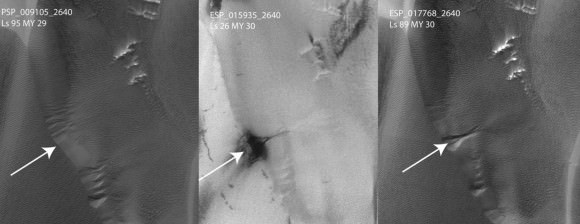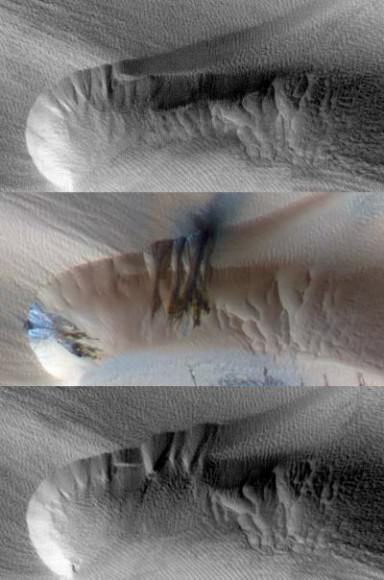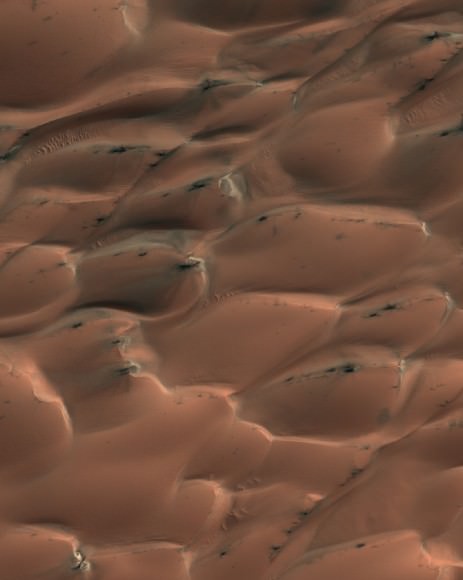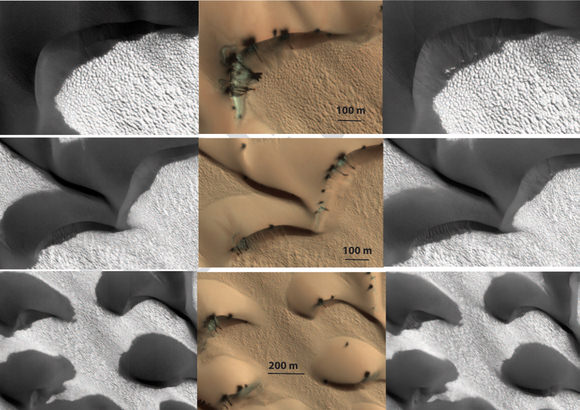[/caption]
Mars, it is a-changin’, and more than scientists expected. Several series of before-and-after images taken by the HiRISE camera on the Mars Reconnaissance Orbiter the past two years show sand dunes in Mars northern hemisphere changing – both gradually and suddenly. A team of researchers analyzing the images say that the changes have been caused mostly by sand and ice cascading down the slipfaces of the dunes. But, also, there could be “alien” processes that we don’t see occurring on Earth.
“The numbers and magnitude of the changes have been really surprising,” said HiRISE Deputy Principal Investigator Candice Hansen.

In the past, Mars was thought to be a dead world, frozen in time with not many changes taking place on its surface. But since the arrival of high-resolution cameras orbiting the Red Planet – first on the Mars Global Surveyor, and now on MRO and ESA’s Mars Express – that notion has fallen by the wayside. Avalanches, new gullies and now shifting sand dunes are appearing regularly on images from Mars.
Even with the known winds on Mars, scientists had considered the dunes to be fairly static, shaped long ago when winds on the planet’s surface were thought to be much stronger than they are today.
Hansen and her colleagues’ new paper that is published in this week’s edition of the journal Science identifies the seasonal changes from a layer of frozen carbon dioxide – a.k.a or dry ice – which covers the region in winter and sublimates away in the spring, along with stronger-than-expected gusts of wind as initiating sand transport on the northern dunes of Mars.

“This gas flow destabilizes the sand on Mars’ sand dunes, causing sand avalanches and creating new alcoves, gullies and sand aprons on Martian dunes,” Hansen said. “The level of erosion in just one Mars year was really astonishing. In some places hundreds of cubic yards of sand have avalanched down the face of the dunes.”
Recently, scientists have seen how the scars of past sand avalanches could be partially erased in just one Mars year. Models of Mars’ atmosphere do not predict wind speeds adequate to lift sand grains, and data from Mars landers such as Phoenix show high winds are a rare occurrence.
“Perhaps polar weather is more conducive to high wind speeds,” Hansen said.

The researchers say changes were seen in about 40 percent of far-northern monitoring locations over the two-Mars-year period of the study.
Related research with HiRISE previously identified gully-cutting activity in smaller fields of sand dunes covered by seasonal carbon-dioxide ice in Mars’ southern hemisphere. A report four months ago showed that those changes coincided with the time of year when ice builds up.

“The role of the carbon-dioxide ice is getting clearer,” said Serina Diniega of NASA’s Jet Propulsion Laboratory, Pasadena, Calif., lead author of the earlier report and a co-author of the new report. “In the south, we saw before-and-after changes and connected the timing with the carbon-dioxide ice. In the north, we’re seeing more of the process of the seasonal changes and adding more evidence linking gully activity with the carbon dioxide.”
“Understanding how Mars is changing today is a key first step to understanding basic planetary processes and how Mars changes over time,” said HiRISE Principal Investigator Alfred McEwen, a co-author of both reports. “There’s lots of current activity in areas covered by seasonal carbon-dioxide frost, a process we don’t see on Earth. It’s important to understand the current effects of this unfamiliar process so we don’t falsely associate them with different conditions in the past.”
Source: Science


The alternate seasons On Mars are 54% longer than on Earth. Winter here seems long enough as it is here at the half way point, but wintering over at Mars is probably best done from orbit for the time being.
I still like the idea of refurbishing one of the old KH-11 spy satellites that are out there on orbit. Rebuild the computers, camera’s, instruments, solar panels, propulsion system and power supply (Ion and nuclear) and launch to Mars orbit!
Later manned missions to recover and de-orbit the nuclear power source. It will then be used to melt and distill water ice, generate oxygen, hydrogen and electricity for a surface laboratory/habitat with attached permanent weather station.
OoPs… Sorry… I started dreaming about the (distant) future again…. out loud.
How do scientists know its Carbon Dioxide? Can anyone suggest verified test results confirming this? Or is it a (hypothetical) assumption? Is the next rover going to investigate these sandune ‘blooms’ ?